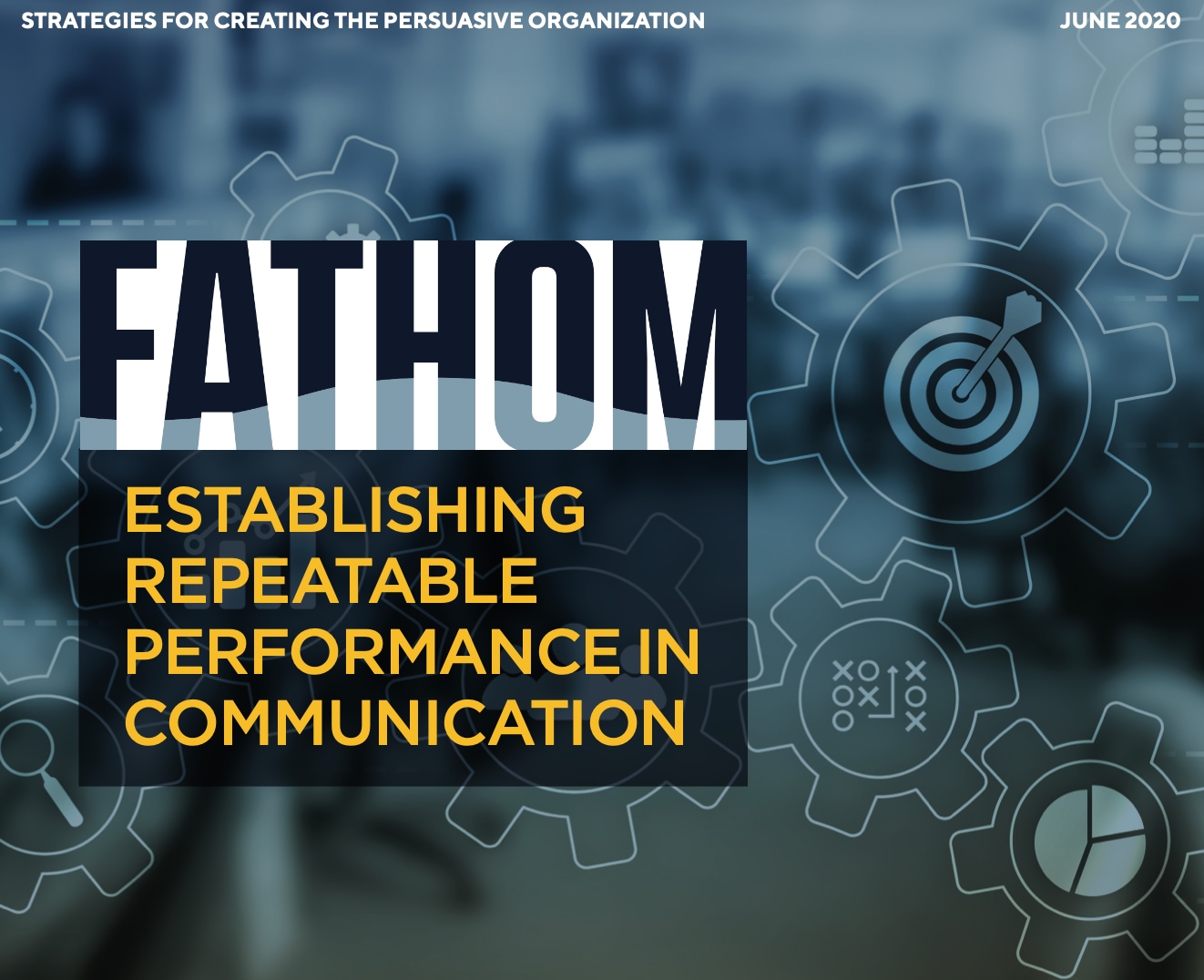Read this issue in its original magazine format.
How leadership can institute a culture and practice that produces consistent, powerful results.
Across industries, executives strive to create a culture of repeatable performance—a standard of work that promotes consistent, efficient, and predictable outputs. Yet when it comes to communication—one of the most integral components of any successful company— corporate leadership has rarely sought to set frameworks and standards to create a similar threshold of repeatable performance.
The reasons vary, but essentially this oversight comes down to the misperception that communication is a “soft skill.” This term has a toxic effect: it diminishes the importance of communication. It implies that a strong performer can get by without it and, even more, that if you aren’t naturally gifted at it, you probably don’t need to (and maybe can’t) get better.
Yet, as the noise of our business life has amplified, the value of a communicator who can simplify information into a concise, memorable, and digestible form has skyrocketed. For executives in particular, communication is a power skill.
As a critical component of modern business, we all must look more closely at how to make communication a learned, practiced series of inputs that lead to a predictable output. That is, we need to approach communication as a process of standard work.
What is Standard Work?
The idea of standard work has been around since the turn of the 20th century, but the idea blossomed in the 1980s with the success of the Toyota Production System. Their definition points to “a detailed definition of the current best practices for performing a process.”1 While a process is understood to be repeatable, it is also understood to be constantly improvable: with the concept of kaizen, participants in the system continuously seek to refine the process to produce the best, most predictable outcome.2

Around the same time as Toyota’s success in the marketplace began drawing attention to their manufacturing process, Six Sigma—a set of manufacturing standards meant to reduce the occurrence of defects to nearly zero—emerged, first at Motorola and later at General Electric.3 Each of these processes has evolved over the years as they were adapted and applied across industries from manufacturing to finance to health care.
Standard work comes into play with elite athletic training, as well. Elite athletes don’t simply run a course or play a game from start to finish in practice; rather, they select elements of the race or the match to break down into specific actions. They can train their bodies to smoothly and rapidly execute the sequence automatically, making it more efficient and effective.
For example, consider Dean’s experience in Olympic sailing:
“Every race has a few key moments that require a specific set of maneuvers. When I was training for the 2000 Olympic team, one particularly difficult sequence of maneuvers might only take 90 seconds to perform, but it was so important to our success that these moves be executed flawlessly that we would practice the sequence again and again and again—sometimes for five or six hours at a time. That consistent, repetitive work resulted in smooth, seemingly effortless execution. Our muscle memory would kick in, and we could perform the maneuvers in exactly the same way every time, with precision and efficiency.“

Communication as a Repeatable Process
When we think about producing a piece of equipment—seats for an airplane, perhaps—creating a repeatable process that ensures that each seat looks, feels, performs, and costs the same makes sense. In communication, the goal should be to create a process that is efficient, persuasive, and repeatable.
For corporate leadership, being able to depend on direct reports to communicate consistently and effectively should be a given. For employees, knowing that communication from leadership is clear and straightforward reduces frustration and boosts efficiency and morale. A model of standard work in communication takes in every form of business communication: not just presentations, but meetings, conference calls, emails between colleagues, conversations between executives and their reports.
Thinking of communication as a repeatable process saves time (and money). Implementing a standard framework around which to build communication processes means that communication becomes a set of easy-to-repeat steps that eventually become nearly instinctual. Once this state is reached, the amount of time spent creating effective communication goes down, and the return on investment—the likelihood of a positive outcome—goes up.
And just as producing a consistent product—those comfortable, durable seats—creates a healthy brand identity for a company, consistently high-level communication boosts reputation, both individually and institutionally.
The cycle also becomes self-reinforcing. As the process of producing high-quality, high-impact communication becomes more natural, it also boosts confidence—an unquantifiable but significant benefit that also increases the likelihood of success.
How Leaders Can Create Standard Work for Communication
Implementing a repeatable, standardized process for communication requires clear expectations from the top, along with a framework of communication “inputs” that can create a consistent “output” of persuasive, clear communication.
Adapting to a standard work process for communication requires a three-pronged effort from the executive suite.
- First, make expectations clear. Establish a mandate for the practices that make up the standard work, and institute metrics to measure their success. Then offer consistent feedback on how well they are being executed.
- Second, model the process. As Fred Rogers liked to say, “Attitudes are caught, not taught.” Without buy-in and consistent practice at the top, it will be difficult to get the wider organization to commit to a standard process.
- Third, reinforce the mandate with training. Employees do better when they know better. A focus on communication skill development reinforces the repeatable process.
Model
In communication, the process of standard work should be embedded in a culture that is embodied and exemplified by leadership—and that culture must be one of respect, empathy, curiosity, and transparency.
In a culture of respect and empathy, multi-tasking is discouraged. Executives set the tone by turning off their phones and laptops during meetings, refraining from interrupting the speaker, and paying attention to not just words, but body language, tone, and emotion. High-quality listening is the bedrock of high-quality communication. Be aware of the value of everyone’s time: be direct, concise, and emphasize what is important to that person.
In a culture of curiosity, executives value what they learn about their clients and colleagues across multiple dimensions—both professionally and personally. Social psychologist Edgar H. Schein calls this “Humble Inquiry”: “the fine art of drawing someone out, of asking questions to which you do not already know the answer, of building a relationship based on curiosity and interest in the other person.”4 Small talk and niceties aren’t a waste of time: they give insight into the pressures and concerns others are feeling. Relatedly, a culture of transparency values sharing your own context to forge stronger connections.
Mandate
Clear expectations of how to approach communication are key in establishing and adhering to standard work. Every business will have its own priorities, but examples include:
- Start and end meetings on time
- Circulate agendas
- Always be prepared
- Take notes
- Curate support materials (avoid the data dump)
- Be purposeful, articulate a clear goal
- Demonstrate knowledge of your audience
Of course, setting out these expectations is important—but leadership can’t expect reports to adhere to them over the long term if they don’t practice them as well.

Reinforce
Training models can both assist in the implementation of standard work and provide continuous support and practice of the skills that go into that process. At The Latimer Group, our model includes a breakdown of four essential skills: Assess, Message, Document, and Deliver. Every company can use a customized implementation of these skills to best meet their particular needs, but a general sense of how these might be structured can be seen in the key strategies that form the process around these skills.
Assess: The “work” here is more about broadened perspective than any active steps taken or frameworks applied. We believe that the standard work of good communication starts with the right attitudes, where the organization makes clear the importance of listening, awareness, intellectual curiosity and respect. If these things are not valued at the organizational level, then communication quickly devolves into a back and forth of what participants all want to say, with no one actually absorbing what is being said. The productive mindset here is one of discovery.
Message: Use the broadened perspective gained in the Assess phase to increase your knowledge and strengthen your preparation. Think about the purpose of the communication, the people who will be receiving it and what their perspective might be, and then outline key points in a structure that emphasizes your goal and connects it to your audience’s priorities. The productive mindset here is one of preparation and clarity.
Document: Support the Message you’ve developed with illustrative materials that make it memorable, and easy to digest. The harder the audience has to work to absorb what they are seeing and reading, the more distracted they will become and the less information that will actually be absorbed. The productive mindset here is one of visual clarity to help avoid cognitive overload.
Delivery: Telegraph confidence by practicing eye contact and purposeful gestures, while eliminating distractions such as verbal pauses or nervous tics. The productive mindset here is one of connection.
Just as in standard work processes in manufacturing or sports, a standard workflow like this one will, over time, create muscle memory. Before long, each element behind the process will be done efficiently, almost intuitively, making powerful, persuasive communication faster, more efficient, and more effective.
Establishing a repeatable process in persuasive communication creates a culture and a curriculum that ensures consistent results, whatever the skill or natural ability of any individual. Leadership that not only sets the mandate, but models it and reinforces it with training and feedback will set in motion massive improvement across an organization. Mandate, model, reinforce: these will produce positive effects on every metric that you consider important.
Powerful communication in the business world is not a luxury—it is a requirement for success. Clear communication can’t be taken for granted. It has to be cultivated. A leadership commitment to putting a process in place, across all levels, helps better, stronger, more persuasive communication thrive.
—

Explore other Issues of FATHOM: Strategies for Creating the Persuasive Organization
- The Mistake of Meetings: FATHOM Issue 1 (2019)
- Establishing Repeatable Performance in Communication: FATHOM Issue 2 (2020)
- Adapting to Virtual Communication and Embracing Its Strengths – FATHOM Issue 3 (2021)
- Best Practices for Strong Virtual Communication – FATHOM Issue 4 (2021)
- The Biggest Roadblock to Organizational Success: Poor Internal Communication: FATHOM Issue 5 (2022)
- Communicating to Belong: FATHOM Issue 6 (2023)
- Building Communication with the Next Generation: FATHOM Issue 7 (2024)
- How to be Heard in a Noisy World: FATHOM Issue 8 (2024)
Sources:
1 Fast, Larry. “Lean Leadership: Understanding the Why and How of Standard Work.” Industry Week.com, September 10, 2019. https://www.
industryweek.com/operations/article/22028213/lean-leadership-understanding-the-why-and-how-of-standard-work
2 Toyota Motor Manufacturing, TMMK, Georgetown, 2007 (Toyota Production System Terms)
TPS Glossary, Toyota (Hand Book) University of Kentucky, Institute of Research for Technology Development, Lean Systems Pro-
gram(2008-2013©) https://w2.engr.uky.edu/lean/reference/terminology/
3 Tennant, Geoff. Six Sigma: SPC and TQM in Manufacturing and Services. Gower Publishing, Ltd. 2001, p. 6.
4 Schein, Edgar H. Humble Inquiry: The Gentle Art of Asking Instead of Telling. Berrett-Koehler Publishers, 2013. P. 2






Comments